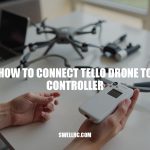How to Bind RC Transmitter and Receiver: A Step-by-Step Guide
The first time I truly “got” RC binding was after a dozen nerve-wracking trial runs on my bench. I’d power up, watch the LEDs mock me, and then — finally — a solid light and a tiny servo twitch. That moment everything clicks is pure magic.
In RC, “binding” is the handshake that pairs your transmitter (TX) with your receiver (RX). It saves a unique code and hopping pattern so your model listens only to your radio — not the neighbor’s. Most modern systems use 2.4GHz radio systems with spread-spectrum technology — goodbye to old MHz crystals — ensuring a reliable link.
Once bound, your connection stays solid across various models including cars, boats, planes, and helis. If you’re new to radio tech, this overview is a friendly start: understanding RC transmitters and radio control systems. In this guide, I’ll walk you step-by-step through RC transmitter setup and remote control binding, share real troubleshooting fixes, and add pro tips I wish I knew earlier.
Whether you’re into binding RC cars, planes, boats, or helicopters, mastering proper RC electronics pairing is key to a smooth experience.
The Science of the Connection — How Transmitters and Receivers Talk
Think of binding like giving two walkie-talkies a private channel and secret handshake. Understanding how do RC transmitters and receivers work involves several key concepts that ensure your commands get through clearly and securely. When you manipulate your controls—sticks, wheels, or switches—the inputs go into the transmitter (TX).
The TX then encodes these inputs using modulation techniques, adds its unique pairing code/GUID, and transmits data employing spread-spectrum methods such as Direct Sequence Spread Spectrum (DSSS) or Frequency Hopping Spread Spectrum (FHSS). This frequency hopping rapidly switches channels to avoid interference and maintains a robust connection.
The receiver (RX) listens specifically for the unique ID or pairing code embedded in the signal and demodulates it back into commands. These commands control servos, Electronic Speed Controllers (ESC), and other onboard components.
Additionally, if your system supports it, telemetry data flows back from the RX to the TX, providing real-time information like battery voltage and signal strength.
Common protocols in use include:
- DSMX/DSM2 for Spektrum radios
- AFHDS/AFHDS 2A for FlySky
- ACCST/ACCESS for FrSky
- FHSS/T-FHSS for Futaba
Here’s a simplified flow of the communication:
| Step | Process |
|---|---|
| 1 | Input → Transmitter (encodes inputs + adds GUID + frequency hopping) |
| 2 | Air (spread spectrum with frequency hopping) |
| 3 | Receiver (decodes and verifies pairing code) |
| 4 | Output → Servos/ESC/gyro/flight controller |
For an even deeper dive into the technology behind these systems, visit this comprehensive guide on how RC transmitters and receivers work.
Gear Check — What You’ll Need Before Starting the Binding Process
Before you bind, double-check the basics with this quick RC pre-flight checklist that has saved me hours of troubleshooting:
| Item | Purpose | Common Mistake |
|---|---|---|
| Transmitter | Sends control signal | Wrong model memory or protocol |
| Receiver | Receives commands | Incorrect channel mapping |
| Bind Plug | Activates bind mode | Plugging into the wrong port (BIND/BATT) |
| Power Source | Powers system | Powering via ESC without disconnecting motor/prop |
| Manual | Exact procedure/LED patterns | Skipping LED indicator check |
Always consult the manual for your exact brand, whether it’s the Spektrum bind plug method, Traxxas binding procedure using the link button, or FlySky transmitter specifics. Each manufacturer has subtle differences, so reading the instructions ensures proper receiver failsafe setup and smooth operation.
For a comprehensive walkthrough, check out this helpful guide on how to sync an RC car remote. Also, remember safety first: always remove propellers from planes and helis, and lift wheels off the ground for cars and boats before testing to avoid accidents.
Step-by-Step Guide — How to Bind RC Transmitter and Receiver
When learning how to bind an RC transmitter and receiver, understanding the correct procedure is essential for a successful connection. The classic bind plug method involves several careful steps:
- Power off all devices. Remove props such as aircraft blades and keep wheels off the ground for cars or boats to prevent accidents.
- Insert the bind plug into the receiver’s BIND or BATT port, or press and hold the RX bind button if your receiver has one.
- Power on the receiver and look for a rapid-flashing LED indicating it is in bind mode.
If the LED doesn’t flash, recheck the port and polarity to ensure correct setup.
- Activate the transmitter’s bind mode. This often requires holding the TX bind button or switching to “Bind/Pair” via the radio’s menu. Keep the transmitter within 1–2 meters of the receiver to avoid overloading the receiver front end.
- Wait for the receiver LED to become solid or show a slow flash, depending on the brand.
This signifies a successful bind.
- Power everything off, remove the bind plug, then power on the transmitter first followed by the receiver. Test servo and ESC responses to confirm communication.
- Set the receiver’s failsafe. Some protocols capture failsafe settings during binding—usually by holding the throttle at neutral and controls centered—while others require configuring failsafe via a separate receiver button or menu.
Modern systems often feature menu-based binding eliminating the need for a physical plug.
Additionally, some receivers support binding without a button or bind plug; consult your manual as certain models auto-bind when powered with the transmitter in bind mode.
Keep in mind that incorrect channel mapping (TAER vs AETR) can cause binding failures. Correcting channel order often results in immediate connection. Also, rotorcraft and planes may require additional calibration steps, such as setting gyro orientation and endpoints, while cars may need ESC calibration after binding.
Properly configuring receiver failsafe setup improves safety and performance during operation.
For further guidance, check comprehensive tutorials on programming remote controls to RC cars and connecting RC helicopters to remotes, which cover nuances beyond basic binding.
Troubleshooting — When Your Transmitter and Receiver Won’t Bind
When troubleshooting binding problems RC transmitter issues, there are several common causes and effective solutions to consider. First, if you encounter situations with no LED or no bind mode, it’s crucial to verify that the bind plug is inserted into the correct port with proper polarity. Additionally, inspect the power supply, because a sagging Battery Eliminator Circuit (BEC) or a nearly empty receiver (RX) battery pack can prevent successful binding.
- Interference nearby: Devices like Wi-Fi routers, laptops, and other 2.4GHz radios can cause significant radio control signal interference that hampers binding. To minimize this, step a few meters away from such sources and keep the transmitter (TX) 1–2 meters from the RX.
- Wrong protocol: Ensure that the TX and RX use matching protocols and regional settings. Examples include DSMX vs DSM2, AFHDS vs AFHDS 2A, ACCST vs ACCESS, and EU LBT vs FCC firmware.
- Firmware mismatch: Updating both the transmitter and receiver to compatible firmware versions is essential. Mixing old and new firmwares, especially with brands like FrSky, Spektrum, or FlySky, can cause silent failures during binding.
- Low voltage/brownouts: If the LED starts to bind then dies, the RX is likely starving for power. Use a charged RX battery pack or a stable BEC providing 5–6V to avoid low voltage brownout conditions.
- Wrong receiver port or reversed signal/ground: Triple-check wiring to ensure the bind port is not mistakenly confused with a channel port and verify correct signal and ground connections.
- Too close or too far: Placing the TX antenna directly on the RX can cause front-end overload preventing binding. Conversely, being too far away (across the yard) might weaken the signal. Maintain an optimal distance for successful binding.
- Reset and retry: Performing a reset by clearing model memory or creating a new model, power-cycling, and attempting to bind again can help. Some receivers require a full reset by holding the F/S button at power-up; this is a key step in how to reset RC transmitter and receiver setups.
- Lost bind mid-use: This often indicates power or antenna issues. Inspect antennas for damage, secure RX mounting, verify BEC voltage under load, and rebind while setting failsafe correctly.
- Brand-specific help: For Traxxas users, following a dedicated guide like how to link a Traxxas TQ remote can make re-linking straightforward.
Based on personal insight, most failed binds encountered over the years were due to voltage-related issues—specifically weak BECs or tired RX batteries which can waste an entire afternoon troubleshooting. As a pro tip, once binding is successful, perform a range test using your radio’s low-power test mode. This approach is recognized as the best way to test RC signal range, ensuring you maintain control at reduced power tens of meters away with antennas oriented optimally.
Advanced Binding and Customization Options
Once you’re bound and confident with your setup, unlocking performance upgrades becomes essential for advanced flying. Key steps include:
- Multi-receiver setups: Some radios support multi-receiver binding, allowing you to connect multiple receivers to one multi-model memory. For example, dual receivers in large planes enhance redundancy.
Assign distinct ports and test each signal path thoroughly.
- Model Match/ID: Brands like Spektrum offer advanced binding features such as Model Match, which locks a specific model memory to its receiver. This ensures safety by preventing the wrong model from controlling your craft.
- Failsafe tuning: Proper receiver failsafe setup is critical. Program throttle to neutral or idle, set safe control positions, then confirm by turning off the transmitter (TX) and observing the model’s behavior to avoid unexpected actions.
- Channel mapping and mixes: Standardize channel orders like AETR or TAER across your fleet for consistency.
Then customize rates, exponential controls, and mixes for functions such as flaps or gyro gain to optimize handling.
- Telemetry and alarms: Integrate sensors monitoring voltage, RSSI, temperature, and current to provide telemetry data. Alerts from these sensors notify you of potential issues before they cause a crash.
- ESC alignment and calibration: Following binding and channel verification, calibrate your electronic speed controller (ESC) endpoints. This ensures the throttle response is linear and predictable.
For a quick refresher, check out how to connect an RC speed controller.
- Upgrading your radio: Consider investing in higher-end radios that feature cleaner gimbals, reliable RF links, and smart functionalities to enhance control. If focused on aircraft, explore the best RC plane transmitters to find models suited to your flying goals.
From DIY to Mastery — Building Confidence through Practice
There’s a special satisfaction when a freshly bound model answers every command — that first clean servo twitch never gets old. Building confidence in your RC skills starts with consistent habits. Bind carefully, confirm LED states, test controls thoroughly, set your failsafe, and always run a quick range test routine before taking off.
The more you develop protocol understanding, the more you’ll trust your connection and equipment performance.
To deepen your knowledge, check out this friendly explainer on how RC controllers work. If you’re the creative type, exploring how to make an RC helicopter remote might be an enjoyable rabbit hole to dive into.
Remember, RC practice makes permanent. Taking notes, labeling your model memories, and revisiting your setup after the first few runs or flights will help reinforce your skills and streamline troubleshooting.
Here’s a quick checklist for effective confidence building:
- Bind your model carefully and confirm LED indicators.
- Perform a thorough control test before flight/run.
- Set and verify your failsafe settings.
- Run a comprehensive range test routine to ensure reliable signal strength.
- Keep detailed notes and maintain organized model memory files.
Conclusion: Perfecting the Link — The Real Joy of a Seamless RC System
Binding is the quiet hero of reliable RC operation — a short ritual that unlocks total trust between your hands and your machine. When you perform an RC transmitter setup, you engage in remote control binding, a crucial step that ensures your transmitter and receiver communicate flawlessly. Understanding 2.4GHz radio systems and the nuances of RC electronics pairing is vital to achieving a safe and effective connection across various models including cars, boats, planes, and helis.
The emotional payoff is real: that first successful bind changes how you see your craft and elevates your confidence in control. Here’s why this step is indispensable:
- Reliable Signal: Binding guarantees a strong and interference-free connection.
- Safety: Prevents unexpected loss of control by ensuring only your transmitter links with your receiver.
- Versatility: Enables quick transitions between different models and equipment.
To help you visualize the key elements, here’s a brief comparison of common 2.4GHz radio systems used in RC binding:
| System | Binding Method | Range | Common Use |
|---|---|---|---|
| DSM2/DSMX | Bind Plug or Button | Up to 1 km | Cars, Planes |
| FrSky ACCST | Soft Bind via Transmitter | Up to 2 km | Helis, Drones |
| Flysky AFHDS | Bind Button | Up to 500 m | Entry-Level RC |
From here, keep refining your process, explore new transmitters and receivers, and enjoy the ongoing discovery that makes this hobby so addictive. Master the signal, and the rest of your RC journey gets smoother, faster, and a lot more fun.
Frequently Asked Questions
- What does binding mean in RC transmitters?
Binding is the pairing process that stores a unique ID and hopping pattern in the receiver so it listens exclusively to your transmitter. It also often records failsafe behavior so the model knows what to do if the signal is lost. - How do I know if my RC receiver is bound correctly?
You’ll see the receiver LED change from fast-blink to solid (brand-dependent), servos/ESC will respond smoothly, telemetry (if available) appears on the radio, and control still works after a full power cycle with the bind plug removed. A short range test is the final confirmation. - Can you bind any transmitter to any receiver?
No. The TX and RX must share the same protocol and often the same brand/region firmware (e.g., DSMX, AFHDS 2A, ACCST/ACCESS, FHSS). Multi-protocol modules can bridge some gaps, but you can’t mix incompatible systems. - Why won’t my transmitter and receiver bind?
Common causes are wrong protocol/region, low RX voltage, interference, incorrect bind port or polarity, firmware mismatch, or the TX being too close to the RX. Update firmware, check power and wiring, move a meter or two away, and try again with the correct model memory. - How do you bind a Traxxas TQ transmitter?
Power on the transmitter, then press and hold the SET button to enter link mode (LED blinks). Power the receiver and press its LINK button. When both LEDs turn solid, the system is linked. Finally, calibrate the ESC per the manual. - What happens if you lose binding mid-flight or mid-drive?
A correctly set failsafe takes over — throttle goes to neutral/idle and controls center or move to preset positions. Land or stop safely, then inspect antennas, power wiring, and receiver mounting, and rebind. Never fly or drive with an intermittent link. - Do you need to rebind after changing batteries?
Usually no. Binding is stored in the receiver’s memory. You may need to rebind if you reset the receiver, update firmware across protocols/regions, change model memory (with features like Model Match), or replace the RX. Recheck failsafe after any major change.



